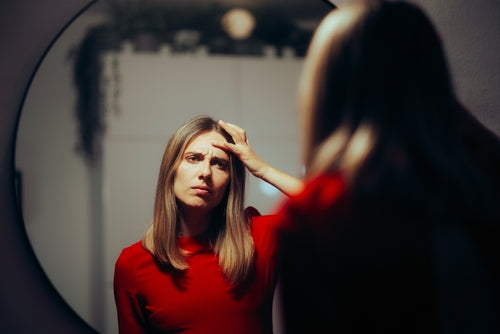
Have Hormones Hijacked Your Skin?
Remember when you could pull an all-nighter, wash your face with whatever bar soap was in the shower, and still wake up with glowing skin? Ah, those were the days. Then somewhere around 35, things start to shift. You notice a random breakout here, a dry patch there, and fine lines that refuse to budge no matter how much moisturizer you slather on.
Spoiler alert: it’s not just you — it’s your hormones.
The Hormonal Plot Twist After 35

Around your mid-30s, estrogen (your skin’s BFF) starts its slow decline. Estrogen is the hormone that keeps your skin plump, hydrated, and radiant. As its levels drop, collagen production slows, oil glands take a nap, and skin turnover gets sluggish.
Here’s what that means in real life:
- Dryness and dullness: Less oil means less natural moisture and glow.
- Fine lines and sagging: Collagen and elastin fibers weaken, making skin thinner and less firm.
- Adult breakouts: A drop in estrogen combined with relatively stable testosterone levels can trigger hormonal acne (usually around the chin and jawline).
- Sensitivity: Skin’s barrier weakens, so it’s easier for irritants to sneak in and cause redness or inflammation.
Hormones don’t just affect your mood — they rewrite your skin’s entire script.
How to Care for Hormonal Skin After 35
Luckily, there are ways to restore balance and keep your complexion calm, clear, and radiant — no matter what your hormones are up to.
Feed Your Skin with Plant Power

Hormonal skin loves phytoestrogens — plant compounds that mimic estrogen’s skin-loving effects. Look for serums rich in plant stem cells, which help rejuvenate tired skin and stimulate collagen production naturally.
Try: Adonia Stem Cell Serums — they use organic Greek plant stem cells to reduce fine lines, fade uneven tone, and bring back that youthful bounce your skin’s been missing.
Rebuild Collagen — Naturally
By 40, your body produces about 1% less collagen each year, which explains why skin texture changes. Boosting collagen production from the outside in helps your skin stay firm and smooth.
Hydrate Like It’s Your Job

When oil production drops, water loss increases. Swap harsh cleansers for creamy, pH-balanced ones, and layer hydrating serums under your moisturizer. Look for ingredients like hyaluronic acid, aloe vera, and squalane to lock in moisture.
Pro tip: Apply moisturizer while your skin is still damp — it helps seal in hydration.
Balance, Don’t Battle, Hormonal Breakouts
If you’re suddenly dealing with adult acne, avoid the teenage temptation to go nuclear with drying treatments. Gentle exfoliants (like lactic acid) and anti-inflammatory botanicals (like lavender and chamomile) can calm breakouts without stripping your skin barrier.
Support Hormone Health From Within

Skincare works best when paired with good nutrition and lifestyle support:
- Eat foods rich in omega-3s (salmon, flaxseed, walnuts) to reduce inflammation.
- Get quality sleep — your body restores collagen while you snooze.
- Manage stress — cortisol spikes can worsen breakouts and dullness.
The Bottom Line
Hormonal skin changes after 35 can feel unfair (like, really unfair), but they’re also completely normal. The key is adjusting your routine to support your skin’s new normal — focusing on hydration, collagen renewal, and gentle balance instead of harsh fixes.
Think of it this way: your skin isn’t “aging badly.” It’s just asking for a little extra care as it enters a new phase — and with the right routine, that phase can look every bit as radiant as your 20s, minus the questionable skincare choices.
